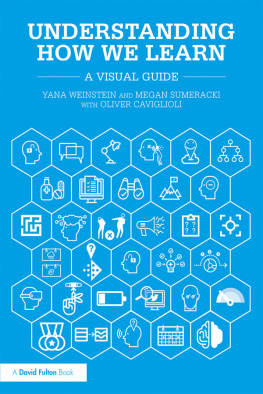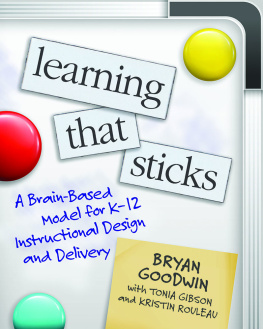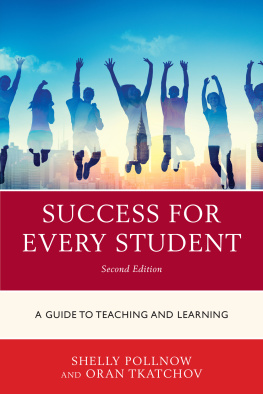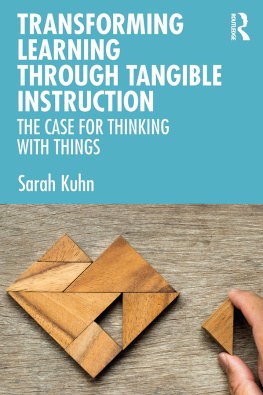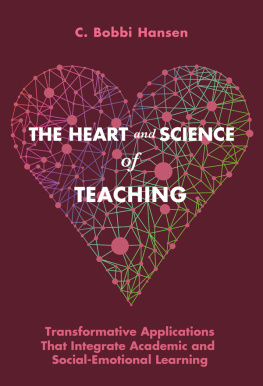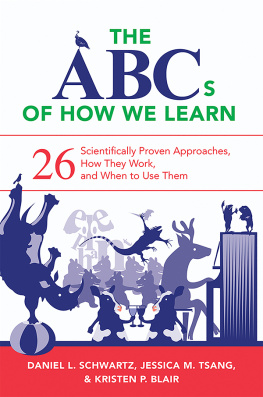Understanding How We Learn
Educational practice does not, for the most part, rely on research findings. Instead, theres a preference for relying on our intuitions about whats best for learning. But relying on intuition may be a bad idea for teachers and learners alike.
This accessible guide shows how to integrate effective, research-backed strategies for learning into classroom practice. The book explores exactly what constitutes good evidence for effective learning and teaching strategies, how to make evidence-based judgments instead of relying on intuition, and how to apply findings from cognitive psychology directly to the classroom.
Including real-life examples and case studies, FAQs, and a wealth of engaging illustrations to explain complex concepts and emphasize key points, the book is divided into four parts:
- Evidence-based education and the science of learning
- Basics of human cognitive processes
- Strategies for effective learning
- Tips for students, teachers, and parents.
Written by The Learning Scientists Drs. Yana Weinstein and Megan Sumeracki and fully illustrated by Oliver Caviglioli, Understanding How We Learn is a rejuvenating and fresh examination of cognitive psychologys application to education. This is an essential read for all teachers and educational practitioners, designed to convey the concepts of research to the reality of a teachers classroom.
Yana Weinstein is Assistant Professor of Psychology at University of Massachusetts Lowell, USA. Yana is co-founder of The Learning Scientists, http://www.learningscientists.org/, a project whose goal is to make scientific research on learning more accessible to students, teachers, and other educators. Yana tweets as @doctorwhy.
Megan Sumeracki (formerly Smith) is Assistant Professor of Psychology at Rhode Island College, USA. Megan is co-founder of The Learning Scientists, where she aims to increase the use of effective study and teaching strategies that are backed by research. Megan tweets as @DrSumeracki.
Oliver Caviglioli was a principal of a special school for a decade, before co-creating the HOW2svisual guides to evidence-based teaching techniques. More recently, Oliver has used a variety of visual formats in different contexts: hand-drawn sketchnotes, digital diagrams, infographics, live hand-drawn conference notes and posters. Oliver is busy on Twitter as @olivercavigliol.
Understanding How We Learn
A Visual Guide
Yana Weinstein and Megan Sumeracki
with Oliver Caviglioli

First published 2019
by Routledge
2 Park Square, Milton Park, Abingdon, Oxon OX14 4RN
and by Routledge
711 Third Avenue, New York, NY 10017
Routledge is an imprint of the Taylor & Francis Group, an informa business
2019 Yana Weinstein and Megan Sumeracki
2019 Illustrations Oliver Caviglioli
The right of Yana Weinstein, Megan Sumeracki, and Oliver Caviglioli to be identified as author of this work has been asserted by him/her in accordance with sections 77 and 78 of the Copyright, Designs and Patents Act 1988.
All rights reserved. No part of this book may be reprinted or reproduced or utilised in any form or by any electronic, mechanical, or other means, now known or hereafter invented, including photocopying and recording, or in any information storage or retrieval system, without permission in writing from the publishers.
Trademark notice: Product or corporate names may be trademarks or registered trademarks, and are used only for identification and explanation without intent to infringe.
British Library Cataloguing-in-Publication Data
A catalogue record for this book is available from the British Library
Library of Congress Cataloging-in-Publication Data
Names: Weinstein, Yana, author. | Sumeracki, Megan, author. | Caviglioli, Oliver, author.
Title: Understanding how we learn : a visual guide / Yana Weinstein, Megan Sumeracki, and Oliver Caviglioli.
Description: Abingdon, Oxon ; New York, NY : Routledge, 2019. | Includes bibliographical references.
Identifiers: LCCN 2018013568 (print) | LCCN 2018028126 (ebook) | ISBN 9780203710463 (ebook) | ISBN 9781138561694 (hbk) | ISBN 9781138561724 (pbk) | ISBN 9780203710463 (ebk)
Subjects: LCSH: Learning, Psychology of. | Cognitive learning. | Effective teaching.
Classification: LCC LB1060 (ebook) | LCC LB1060 .W44 2019 (print) | DDC 370.15/23dc23
LC record available at https://lccn.loc.gov/2018013568
ISBN: 978-1-138-56169-4 (hbk)
ISBN: 978-1-138-56172-4 (pbk)
ISBN: 978-0-203-71046-3 (ebk)
Typeset in Plantin and Helvetica Neue
by Apex CoVantage, LLC
Contents
We would like to thank the Association for Psychological Science, IDEA Education, the Overdeck Family Foundation, and the Wellcome Trust for supporting the Learning Scientists project and helping us to create resources for teachers and students to promote learning. We would also like to thank University of Massachusetts Lowell and Rhode Island College for their support.
We also wish to thank the other researchers on our Learning Scientists team, Cindy Nebel and Carolina Kuepper-Tetzel, who have been wonderful collaborators and friends as well as the numerous teachers, researchers, and other educators who have contributed to our understanding of how we learn, many of whom appear throughout the book.
Yana would like to thank her PhD and postdoc mentors David Shanks, Roddy Roediger, and Kathleen McDermott, who have supported her work for the past decade. Megan would also like to thank her graduate advisors, Roddy Roediger and Jeff Karpicke.
We would like to thank those students in our research labs at University of Massachusetts Lowell and Rhode Island College who continue to contribute to active research on student learning. Students working with Yana Weinstein on science of learning projects are PhD students Meltem Karaca and Marcus Lithander, who feature in with undergraduate research assistant Shannon Rowley, as well as undergraduate student Annmarie Khairalla who worked on the books glossary. Students working with Megan Sumeracki are Masters student Carissa DiPietro and undergraduates Ashley Bazin, Giselle Colon, Elizabeth Greenleaf, and Audrianna Vito. We also wish to thank countless students who have helped directly with the Learning Scientists project, including Rachel Adragna, Emily Castonguay, Elizabeth Greenleaf, Syeda Nizami, and Amalie Ducasse.
Yana would like to thank her husband, Fabian Weinstein-Jones, for enthusiastically embracing all of her ideas and projects, and her four children Aurelia, Katelyn, Ethan, and Fabian for listening to her talk incessantly about learning strategies.
Megan would like to thank her husband, Samuel Sumeracki, for being so loving and supportive. He has contributed to the Learning Scientists project in invaluable ways. She also thanks her mom, Sandy Stuck, who always made sure her life was full of learning.
Finally, we would like to thank Alice Gray, Annamarie Kino, and Clare Ashworth, our editors, and other helpful staff at Routledge for guidance and support during the writing and editing of this book.
Oliver would like to thank his wife, Lyn now three years retired from teaching who still has to put up with his incessant babblings about such and such a teaching strategy. Her support has often veered towards suffering.

